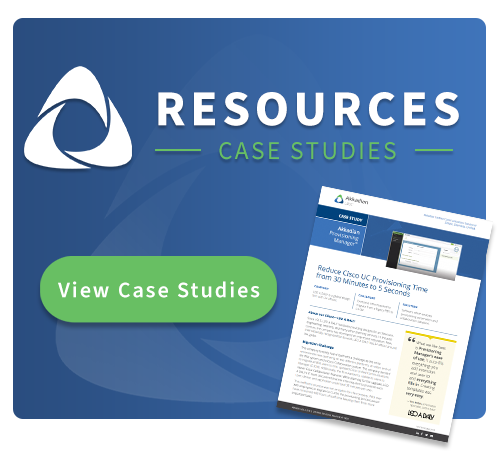Contrary to conventional thinking, a major corporate change is one of the best times to invest in and implement automated UC user provisioning. In this article, we explain why and how the right solution can help you overcome common challenges that typically occur during these changes.
Corporate events like M&A’s, outsourcing and migrations are never easy. They take loads of time and introduce tons of complexity. And when poorly planned out, they can lead to mass confusion, uncertainty and a major drop in productivity.
For these reasons, company executives sometimes put a freeze on spending on new IT initiatives. By doing this they hope to reduce complexity and costs to ensure the change or restructure is successful.
But it’s rarely the case that these events go off without a hitch. When the dust settles, many enterprises find that the steps they took to reduce spending and complexity impeded their teams’ ability to complete the merger or migration successfully.
A more prudent decision would be to invest in a UC service management solution prior to the change so that making these changes is easier, more efficient and less error-prone. These solutions minimize the headache related to UC when going through these events while also allowing you to fully maximize the investment in your UC environment. In fact, in most cases, investing in UC service management prior to these major corporate events tends to make the transition more seamless.
We will cover four major corporate event scenarios and how an automated UC user provisioning solution can help overcome some of the many UC challenges associated with them.
Overcome Complex Change with Automated UC Provisioning
When we talk about major corporate events, we’re specifically talking about these four:
- Mergers and acquisitions
- Moving UC to the cloud
- Migrating to a new UC environment
- Outsourcing UC management to an MSP
Mergers and Acquisitions
When enterprises merge operations, it causes upheaval. Once the purchase goes through, teams must often work around the clock to merge the two IT and UC environments.
Investing in an automated UC user provisioning solution helps ease some of the burden by streamlining many of the manual processes that take time and cause errors, potentially generating many downstream negative effects like service disruptions or even outages.
If the two companies that are merging are on different UC platforms, with the right solution you’ll get native integrations to support provisioning for all major UC providers like Cisco Collaboration, Webex, Microsoft Teams and Zoom. That makes managing a hybrid environment or moving user data between the two UC platforms much easier.
Before merging the two UC systems, you’ll want user accounts to be built consistently. An automated provisioning solution can help you do that using features like job templates and bulk provisioning capabilities. These make migrating and provisioning user data in bulk from one platform to another easy and error-free, reducing the overall workload on your teams.
Ultimately, automated provisioning saves time and allows UC engineers and systems architects to focus on broader, more strategic, IT initiatives when merging two companies.
Moving UC to the Cloud
Cloud-based UC is a great solution for companies who want a secure and easy to manage platform.
However, much like M&A’s, migrating from an on-prem UC environment to the cloud poses many challenges. When done manually, UC engineers spend a lot of time moving data into the new cloud-based applications. This tedious process poses security risks. An automated user provisioning solution with migration tools can streamline the process.
An automated UC provisioning solution can provision users on-prem and in the cloud seamlessly and simultaneously. Look for a solution that can simultaneously provision on-prem solutions (like Cisco Collaboration) and cloud solutions (like Webex, Zoom, Microsoft Teams and others).
Migrating to a New or Hybrid UC Environment
In a similar fashion to moving to the cloud, creating a hybrid UC environment (one with many different UC platforms) presents many challenges that can be solved with the right automated user provisioning software.
Managing moves, adds, changes and deletes (MACDs) in multiple platforms is a difficult task. However, an automated UC user provisioning solution can act as a hub between distinct environments, allowing a single pane of glass to provision in 2 or more UC platforms.
Again, this simplifies the provisioning process, reduces errors and saves time – time that can be redirected to projects that provide a much better ROI.
Considering Outsourcing MACDs to an MSP
Many Fortune 1000 companies have taken steps to outsource MACDs to a third-party managed service providers (MSPs) to save time and reduce the amount of manual work their UC teams are responsible for.
Day-to-day UC operations can easily overwhelm small teams, taking their attention away from more strategic work initiatives. Also, highly educated engineers simply don’t want to do this repetitive, manual work for good reason. MACDs are tedious, rote work. Their time should be focused on strategic projects.
An automated provisioning solution reduces a lot of that burden by getting rid of manual work and turning UC provisioning into a full-cycle, zero-touch automated process. This eliminates the need to outsource those tasks in the first place, saving your company money.
Conclusion: Don’t Wait for the Dust to Settle
If your company is in the middle of – or expecting and planning for – one of these major change events, investing in an automated UC provisioning solution now can help your teams overcome challenges and save time and resources in the process.
At Akkadian, we’ve been helping enterprises through these types of events for years. Our UC management and provisioning solutions, like Akkadian Provisioning Manager, are used by enterprises to streamline their processes, saving time and eliminating errors.
If your company wants to make UC more manageable during a major change or restructure, talk to Akkadian. Sign up for a demo of Akkadian Provisioning Manager.



